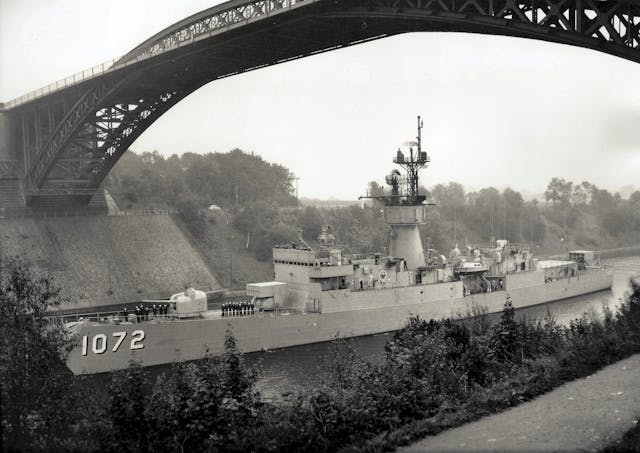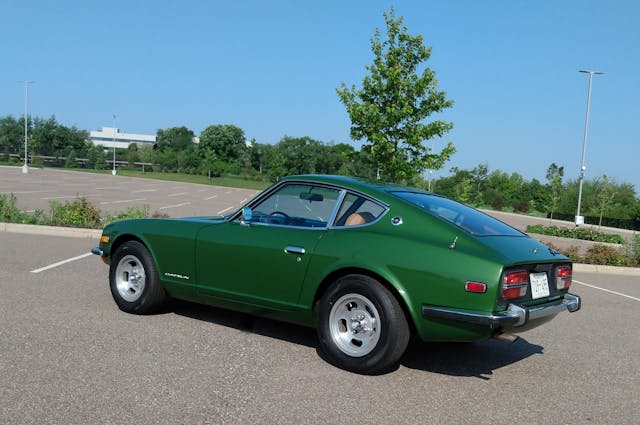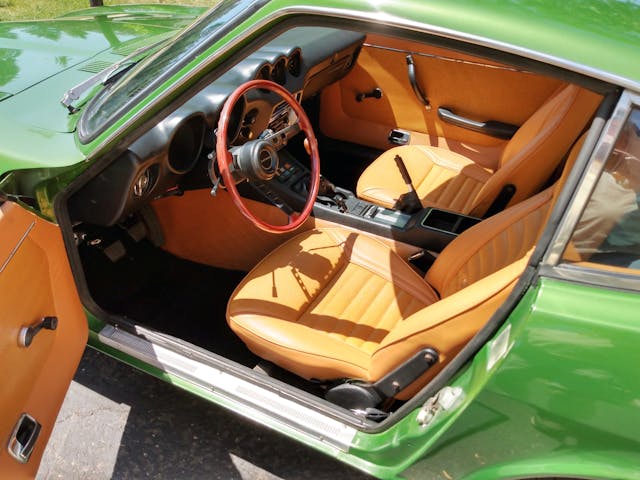Media | Articles
Original Owner: A Navy sailor returns home to a new Datsun 240Z
Welcome to Original Owner, a series showcasing—you guessed it—people who bought a classic car new and still own it. The cars don’t need to be factory-original, just still in the hands of the first owner and still getting driven. —Ed.
Twenty-three-year-old George Carter loved driving his 1971 Fiat 124 Spider. He relished its rev-happy four-cylinder engine, five-speed stick, and dashing Pininfarina design. He’d bought it new but soon fell for a something else that had been tempting him since arriving in early 1970: the Datsun 240Z.
The Z became the sensation of the sports car world, beloved for its powerful inline-six engine, fastback coupe body, and well-finished interior. All of that came with an irresistibly reasonable price—about $3600, or $27,000 today—that sent sales zooming.
Carter’s Fiat still had that new-car smell when he negotiated a trade-in for a 1973 240Z from Morris Motors in Charleston, South Carolina. It was December 1972, and even three years after the 240Z debuted, Carter faced a six-month wait for delivery.
He didn’t mind the delay, though, as he had plans to be out of the country for a few months. Or rather, the U.S. Navy had plans for him. Carter was serving as a Sonar Technician First Class aboard the USS Blakely (DE 1072), a newly commissioned destroyer home-ported in Charleston, some 1300 miles from Carter’s home near St. Paul, Minnesota. The Blakely was scheduled to sail for Vietnam in late fall for its first tour in a combat zone.

The ship left Charleston for the western Pacific on December 1, 1972, and a final leg from the Philippines to Vietnam began on January 7, 1973. A blessing for all aboard, there would be no combat. Peace talks resumed during their voyage and on January 27, the United States and North Vietnam signed the Paris Peace Accords to end the war.
The Blakely was back in Charleston in late March, and Carter took delivery of his 240Z in May. One of his several cross-country trips while on leave was to visit home in Minnesota.
The car served as his daily for many years as well as a weekend autocrosser. Today, following an extensive freshening, it’s strictly a pleasure driver. Notably, Carter’s ’73 240Z was one of the rare ones to leave the dealership with a five-speed manual transmission. Wait a second, didn’t the five-speed debut with the 1975–1978 280Z? Well, some got it a bit earlier.

Datsun 240Z: Factory basics
Few cars have reshaped a well established market as spectacularly as the Datsun 240Z did with sports cars 54 years ago. Datsun had been part of that establishment with its two-seat roadster, called Fairlady in Japan and simply “Sports” in America, since 1963. The Sports 1600 and Sports 2000 ended in 1970, the latter powered by a 135-hp 2.0-liter OHC four.
Big change was afoot. Nissan took a sharp turn away from the roadster with a Jaguar E-Type-inspired GT coupe. Yutaka Katayama, president of Nissan America and affectionally known to Nissan buffs as “Mr. K”, had suggested that such a car would have wider appeal than a roadster. Toyota’s ultra-limited-production 1967 2000 GT was the right idea but at the wrong price, so Nissan designer Yoshihiko Matsuo took up the challenge to develop a similar kind of mass-produced car.

The coupe that emerged (model code S30) was called Fairlady Z in Japan, getting its 240Z name in the U.S., its primary target market, from an iron-block, aluminum-head 2.4-liter SOHC inline-six-cylinder engine. The modern six gave 151 hp at 5600 rpm and 146 lb-ft of torque at 4400 rpm (about 135 net hp.) By comparison, the Triumph TR6 roadster mustered 104 hp from its 2.5-liter OHV six, and Triumph’s Spitfire-based GT6 coupe had a 95-hp 2.0-liter inline-six.

Everything else in the price neighborhood had a four-cylinder engine, and no car in the category could touch the 240Z’s performance. In its June 1970 road test, Car and Driver recorded 0-60 in 7.8 seconds (two seconds quicker than the TR6) and the quarter mile in 16.1 sec. at 87 mph. Road & Track’s numbers, while not quite as quick, were still better than other cars in the price class.
The 240Z carried speed through the curves, too, thanks to four-wheel independent suspension via MacPherson struts in front and Chapman struts out back, as well as rack-and-pinion steering. Two weak points were its choppy ride and diminished braking performance amid road spray in the rain.
Screaming bargain (and race winner)
That $3526 list price (about $150 more than the TR6) made the 240Z an alluring deal, even if dealers padded the price in response to high demand. Also new to the market, Porsche’s 914, at $3600, offered a mere 80 hp from its air-cooled Volkswagen four-cylinder engine.
Like the Datsun Sports 2000 before it, the 240Z became a racing champ. With factory backing, Brock Racing Enterprises, founded by designer and racer Pete Brock, clinched SCCA C-Production National Championships in 1970 and 1971. Connecticut-based Bob Sharp repeated the feat for 1972-73. Farther afield, a 240Z won the grueling East African Safari rally in 1973.

As it had for many British sports cars, the U.S. became the biggest market for the 240Z, taking 90 percent of the approximately 165,000 built through 1973. Canada took 11,200 (7 percent).
To keep up with more stringent emissions regulations, an engine displacement bump to 2.6 liters turned the 240Z into the 260Z for 1974. The final S30, the 1975-1978 280Z, did a better job balancing performance and emissions with a fuel-injected 2.8-liter version and an available five-speed. By the end of the S30’s run, about 520,000 had been built, most sold in the U.S.
George Carter’s car
Many 240Z owners saw their new sports car as a perfect canvas for Day Two modifications for improved performance and handling, and Datsun dealers and the aftermarket eagerly obliged with plenty of add-on parts. Carter ordered several genuine Datsun upgrades through the dealer including, yes, a five-speed manual transmission to replace the Z’s four-speed. Here’s how he got it:
“I was all about sports cars back then,” Carter tells Hagerty, adding that he planned to autocross the car. “An article I read in Road & Track recommended adding heavy-duty front and rear anti-roll bars, headers, and the five-speed. The only way to get that transmission was to order it through what was then called the Datsun Competition Department.”
Carter ordered all those items, plus the slotted “mag” wheels. All appear on his original bill of sale. He later added the BRE-style front spoiler.

“A lot of people retrofit a five-speed from the later 280Z or ZX, but I was able to order this in 1973. It turned out to be an ultra-rare transmission. Very few 240Zs have this.”
Carter’s total purchase price came to $5141.75. “That was a lot back then. I remember being chided about paying over $5000 for a car,” he recalls. List price for the car $4235. The five-speed was $400; mag wheels were $200; headers were $200; and the anti-roll bars cost $100. Those were the installed prices.
His initial color choice had been Silver Metallic, but he became smitten with Green Metallic when he spotted a Z in that hue in the dealer’s service area just before ordering his car. “The earlier green was more of a British racing green, but in 1972 they changed it to this. That’s what they had 1973.”
The Datsun dealer gave Carter $1850 for his ’71 Fiat Spider, half what he paid new. He added $2000 cash to the transaction, leaving a loan balance of $1291.75.
Carter recalls one sour note on delivery.
“The Road & Track article claimed that Datsun Competition Parts installed by the dealer would be covered under the new-car warranty, but that turned out not to be the case,” he says. “I recall them telling me something to the effect that ‘Road & Track magazine does not set Datsun warranty terms.’ They even gave me a piece of their letterhead containing that wording, along with a large red sticker centered on it that said, ‘No Warranty.’ The sticker had been attached to the transmission when received from Datsun. I have unfortunately lost that piece of paper over the years.”
Marketplace
Buy and sell classics with confidence
Life with the Z
Carter knew the 240Z was rust-prone and would be especially vulnerable in Minnesota winters. When he moved back from Charleston in 1974, he had the car under-coated with rustproofing.
“It didn’t stop all the rust, but there wasn’t much to repair before the car was repainted in the Eighties,” he says.
After two years of driving, Carter decided to store the car over winters. When he bought a Camaro in 1995 and then, later, a Corvette, those cars took up his garage, and the Z spent more time in storage elsewhere. As it turned 25 years old, Carter’s Z got its own two-page feature in Nissan USA’s service news magazine, Tech Talk, thanks to his brother, who was the editor.
“The last time it was in storage for over 10 years,” he says. “I took it out about five years ago and revived it—gave it new brakes, clutch, struts, ball joints, anti-roll bar links, fuel pump, and tires and replaced all the rubber components.”

This past winter, Carter treated his classic Z to new upholstery and carpeting.
“The seats were the only things inside that really showed wear. My dash is original. They usually cracked in sunnier climates. Mine didn’t sit outside, and it has one tiny little crack.”
The car currently stays in Carter’s home garage, while his and his wife’s daily drivers are parked outside.
George’s 240Z memories:
Hagerty: How much did you drive the Z when you got it?
GC: All the time. It was my daily driver. And of course, being on a ship at the time, I just needed that outlet, to get out by myself. I drove it cross-country several times. I visited my parents in Minnesota. And I also drove it from Minnesota out to Rapid City, South Dakota. I put a lot of miles on it when it was new.

Hagerty: Was it reliable?
GC: I never had any real trouble with it, but the ’73s had all that smog stuff, and they used a different carburetor than the ’70-’72. Especially being in a hot climate, like Charleston, they had vapor lock problems. You’d take it to the dealer, and they’d install some kit that was supposed to fix the problem. But none of their fixes ever worked well. They even had a hood scoop available if all else failed. It kind of followed the contours of the center hood bulge, with openings on the side. It wasn’t that obtrusive, but I didn’t want it.
Hagerty: Did anything finally work?
GC: The only real fix was to retrofit ’72 carburetors, which I did when I got out of the Navy in 1974 and was back in the Twin Cities. I advertised in the local paper that I was looking for 1972 carburetors. A guy contacted me immediately. He had a set because he was putting triple Webers on his Z. I bought them, and they’ve been on ever since. The ’72 carburetors have a different look. They’re a copy of the British SU carburetor, built by Hitachi. They’re known as ‘round tops,’ while the ’73 240Z and the ’74 260Z used ‘flat tops.’
Hagerty: How was the five-speed on the street?
GC: It worked fine. But it had a higher first gear than the four-speed, which made it a little more challenging pulling away from a stop.
Hagerty: Was the repaint the original color?
GC: No, it’s a similar Corvette color called Elkhart Green used in 1972 and 1973. A friend painted the car. We stripped the car down to bare metal. My friend sprayed on lacquer paint, and then we hand-rubbed it. It has stood up well after 40 years.

Hagerty: What are your best memories with the 240Z?
GC: I would say some of my cross-country trips were really enjoyable. I autocrossed it quite a bit in my younger days, and that was always a lot of fun.
Hagerty: Does the Z still get attention after 50 years?
GC: Occasionally I’ll have somebody honking their horn or giving a thumbs-up. But not everybody knows what it is. Here in the Midwest, they weren’t nearly as common as they were on the coasts. My next-door neighbor asked, ‘What is it?’ He was just young enough that he’d never seen one before.
Hagerty: Was there a point that you thought you’d be keeping this car forever?
GC: Yes, when it was new! As the years went on, there were times I thought, I’m not using that car, I should just sell it. My wife doesn’t want me to sell it, though. She always says, ‘You’ve brought it this far.’ My Camaro and Corvette are gone, but I still have the Z.

__
Car: 1973 Datsun 240Z
Owner: George Carter
Home: St. Paul, Minnesota
Delivery date: May, 1973
Miles on car: ~70,000
***
Are you the original owner of a classic car or do you know someone who is? Send us a photo and a bit of background at editor@hagerty.com — you might get featured in our next installment!
Check out the Hagerty Media homepage so you don’t miss a single story, or better yet, bookmark it. To get our best stories delivered right to your inbox, subscribe to our newsletters.












I watched my older brother in-law show up at the house driving his brand new 240Z and it was the absolute coolest car I had ever laid eyes on. When it came time a few years later to purchase a second family car for my mother I was able to convince my father that we should take a serious look at the new 260Z…took it on a test drive with my Mom and it promptly died in middle of an intersection and ended up being towed back to the dealership…..end of discussion as far Datsun was concerned
I once had a 71 240Z ,i’ve Also had 4 mgb and mgbgt .I still have a 1974 mgbgt. I have owned the bgt for approx.40 years. I’ve always loved the looks of my mgs ,but lately I can’t stop thinking of my 240z,I now believe my 240Z was a better looking car than my mgs .Hopefully my mg can’t hear me. Oh I think the looks of the 240 went down hill when the 260,280 came out. One last thing, my74 MGBGT is 100% original.